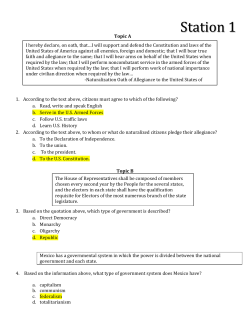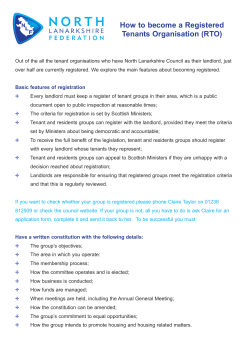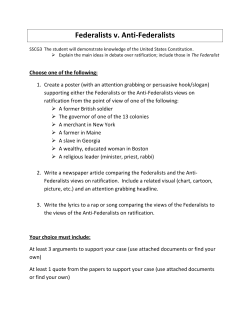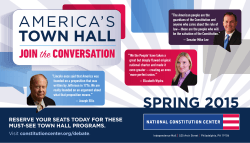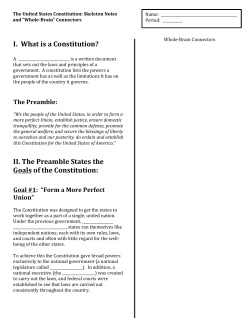
AP Government Summer Assignment Total Possible points: 150
AP Government Summer Assignment Total Possible points: 150 (counts as 1.5 tests!!!) There are two different methods to amending the Constitution. The first is by Formal Amendment. Since the Constitution was first ratified it has only been formally amended (changed) 27 times. Although formal changes are rare, informal changes are much more frequent. One of the reasons the Constitution has endured for so many years is because of its simplicity. The Founding Fathers knew that society would change drastically over time and therefore any detailed provisions would soon be outdated. Instead, they created the Constitution as a “blueprint” or “skeleton” that would be able to adapt to changing times. There are four main ways that the Constitution can be informally changed: 1. 2. 3. 4. The government can pass legislation (laws) Party practices The everyday operations of the government Supreme Court rulings that clarify how the Constitution should be interpreted AP Government Summer Assignment Part I (18 points) For this assignment the focus will be on #4 from above. In order to receive full credit for the summer assignment please complete the following tasks: 1. Federalism is a unique characteristic of the structure of the United States government. a. Define Federalism (3 points) b. Provide one example of how American system of Federalism allows for effective governing. (3 points) c. Provide one example of how the American system of Federalism provides a barrier to effective governing (3 points) 2. Define Civil Liberties (3 points) 3. Define Civil Rights (3 points) 4. Identify the main difference between Civil Liberties and Civil Rights. (3 points) AP Summer Assignment Part II (132 points) Note: Complete part I before attempting part II. All of the decisions by the Supreme Court in the cases listed below had a significant impact on how the Constitution is interpreted (landmark cases). For each of the cases please provide the following information: 1. Case Summary (2 points) a. Tell the story of what happened in the case and who was involved (about a paragraph) 2. Majority Opinion (including the part of the Constitution cited in the decision). In other words, how did the Supreme Court rule in the case and what part of the Constitution did they use to justify their decision? (2 points) 3. Was this case a Civil Liberties, Civil Rights, and/or Federalism case and why is the case in that category? (2 points) Example: Case: Brown v. Topeka Board of Education 1. Case Summary: Mr. Brown wanted to send his daughter to an all-white school that was only about a block from their home. His daughter was unable to attend that school and had to go to a school that was significantly farther away. Mr. Brown challenged the school district policy of segregated schools, and brought suit against the district in an attempt to allow his daughter to attend the school that was closest to their home. 2. Majority Opinion: The Supreme Court ruled 9-0 in favor of Brown. In their decision, the Supreme Court cited that the separate but equal doctrine that came from the case Plessy v. Furgeson was a violation of the 14th Amendment Equal Protection Clause. The Court ruled that separate was inherently unequal. The Court was heavily influenced in their decision by the “doll test” which showed that segregation was doing harm to African-American children. The court ordered the desegration of all schools in a reasonable amount of time. 3. Categories: This is a Civil Rights case because the girl belonged to a category of people (AfricanAmericans) who had been historically discriminated against due to a common characteristic. This is also a Federalism case because the Federal government struck down all state segregation laws as unconstitutional (violation of the 14th Amendment Equal Protection Clause) ***Oyez.com is a great resource to find the decision and the Constitutional reasoning behind it. However additional sources will be necessary in order to explain the case in detail.*** 1. 2. 3. 4. 5. 6. 7. 8. 9. 10. 11. 12. 13. 14. 15. 16. 17. 18. 19. 20. 21. 22. Lochner v. NY Schecter v. US Printz v. US Plessy v. Furgeson Hammer v. Dagenhart Lopez v. United States Dred Scott Decision Rowe v. Wade Miranda v. Arizona Windsor v. United States Mapp v. Ohio Gideon v. Winright New York Times v. US Miller v. California Engle v. Vitale Lawrence v. Texas Tinker v. Des Moines District of Columbia v. Heller Gitlow v. New York Texas v. Johnson Griswold v. Connecticut Roth v. United States Students: I check my email frequently (kellystu@leeschools.net) . Please feel free to email any questions you might have. I’m very much looking forward to the class next year! -Ms. Stutz
© Copyright 2025
